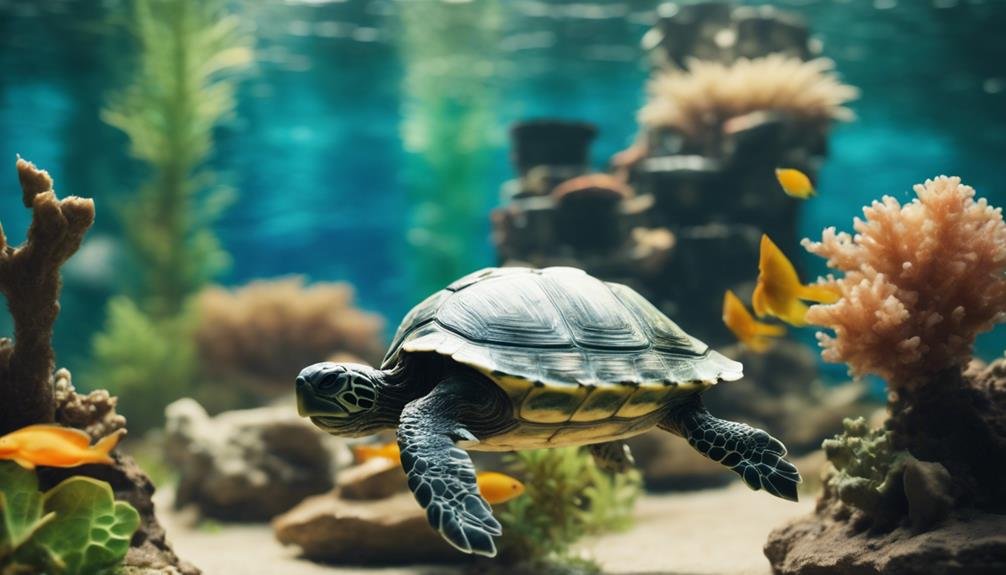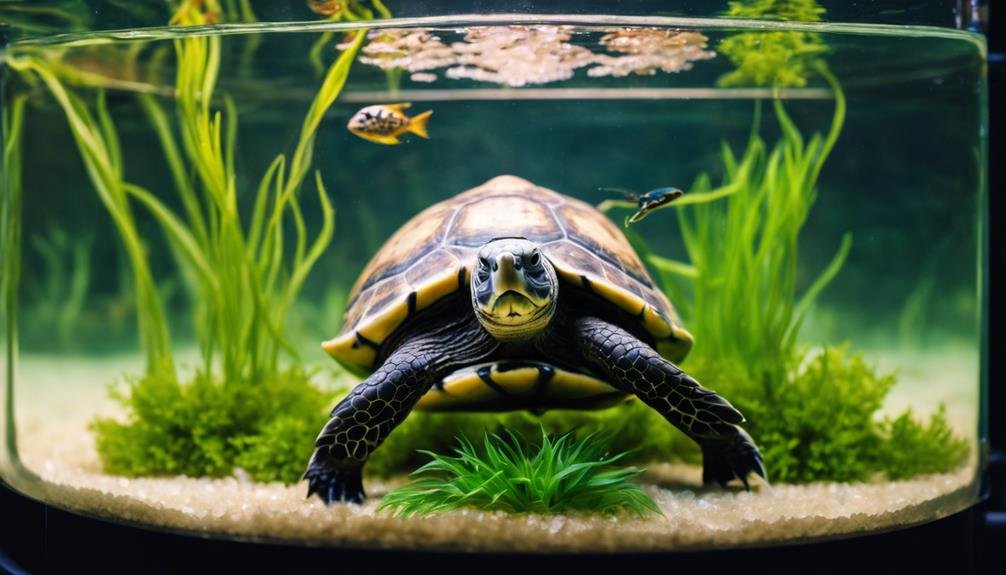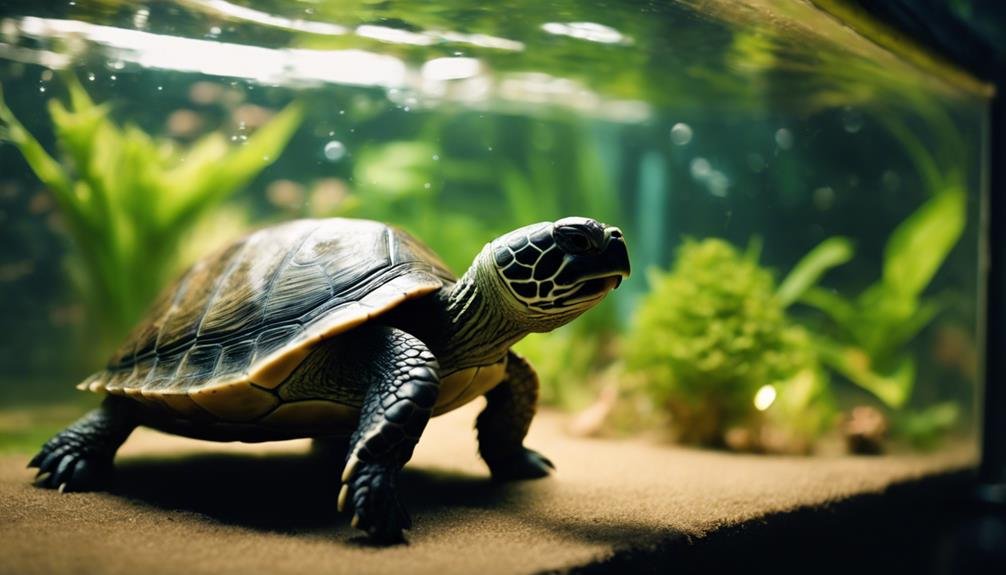Maintaining a clean turtle tank might seem challenging, but it’s essential for your turtle’s health and happiness. You’ve probably heard about the basics: regular water changes and monitoring water quality. However, there’s much more to explore, from selecting the right filtration system tailored to your turtle’s needs to understanding the impact of feeding practices on water cleanliness. If you’re wondering how these elements work together to create a pristine environment for your turtle, you’ll find that diving into the specifics can provide insights that might transform your approach to turtle care.
Key Takeaways
- Perform weekly partial water changes of 25-50% using a gravel vacuum for substrate cleaning.
- Regularly test water for pH, ammonia, nitrates, and nitrites to maintain optimal levels.
- Choose the right filtration system and perform maintenance every 2-3 months.
- Conduct 10-20% partial water changes every 1-2 weeks to remove debris and maintain water quality.
- Feed turtles outside the tank and promptly remove uneaten food to minimize waste accumulation.
Establishing a Cleaning Routine
To keep your turtle’s tank water pristine, it’s important to establish a consistent cleaning routine, starting with weekly partial water changes of 25-50%. These changes are necessary for removing waste that accumulates in the water, ensuring the habitat remains healthy for your aquatic turtles. Alongside these changes, incorporating a gravel vacuum to clean the substrate helps eliminate debris and prevent the buildup of harmful bacteria.
Maintaining your filter is another critical step in this routine. Your filter works tirelessly to keep the water clear and free from contaminants, but it can’t do its job effectively if it’s clogged with debris. Monthly cleaning of the tank decorations and filter media is essential to prevent harmful bacteria from thriving in your turtle’s environment. This doesn’t just keep the water clean; it also supports a stable pH level, which is paramount for the health of your turtles.
Monitoring Water Quality
Regularly testing your turtle tank’s water for pH, ammonia, nitrates, and nitrites helps maintain a safe and clean environment for your turtle. By using a water testing kit, you can monitor these levels closely. It’s important to keep pH levels between 7 and 8, ideal for most turtles, including the popular Red-Eared Slider. If you find the chemical levels off, adjust them with additives or a water conditioner to guarantee the tank’s ecosystem is balanced.
Adding one teaspoon of non-iodized salt per gallon of fresh water can greatly reduce harmful bacteria, supporting the health of your turtle. This practice, combined with the right balance of beneficial bacteria, helps break down waste products efficiently, minimizing the need for a complete water change.
Choosing the Right Filtration


Selecting the ideal filtration system is a pivotal step in guaranteeing your turtle tank remains clean and healthy. When choosing a turtle tank filter, you’ll need to take into account the flow rate, filtering capacity, and maintenance needs. These factors are essential for maintaining a pristine environment for your aquatic friend.
Different types of turtle tank filters are available, including Hang-on-Back, Internal/Submersible, Canister, Sumps, and even DIY options. Each has its unique advantages and setup requirements, so you’ll want to pick one that best fits your tank’s size and your turtle’s needs.
Components of these filters typically offer mechanical filtration, which is vital for removing waste like uneaten food, feces, urine, and detritus. Regular maintenance, including water changes and filter cleaning every 2-3 months, is key to keeping your tank’s water clean and healthy.
- Feel the pride: Imagine the joy of watching your turtle thrive in crystal clear water.
- Embrace the peace of mind: Knowing your filtration system is efficiently working to maintain a clean environment.
- Enjoy the beauty: A clean tank enhances the beauty of your aquatic setup, making it a focal point of admiration.
Choosing the right filter ensures your turtle’s habitat remains a healthy and visually appealing haven.
Conducting Partial Water Changes
Maintaining your turtle’s tank requires conducting partial water changes of 10-20% every 1-2 weeks, an essential step in guaranteeing a clean and healthy habitat. Given that aquatic turtles spend a significant amount of time in the water, keeping the tank water clean is vital to their health. Clean water is essential not just for the well-being of your turtle but also to maintain the efficiency of your tank filter and prevent the overgrowth of harmful bacteria in the tank.
To perform partial water changes effectively, use a siphon or gravel vacuum to remove debris from the substrate, which can accumulate and degrade water quality. When adding new water, ensure it’s dechlorinated and the temperature matches the existing tank water to avoid stressing your turtle. This practice helps in maintaining the balance of the water, reducing the levels of ammonia and nitrate that can be harmful to your turtle.
Regular water testing is advisable to monitor the quality of the tank water. By conducting these partial water changes, you’re not just removing excess waste but also helping prevent algae growth, ensuring the tank remains a clean and inviting space for your turtle.
Feeding Practices and Tank Hygiene


After understanding how partial water changes contribute to a clean tank, let’s focus on how proper feeding practices and tank hygiene play an important role in maintaining the water’s quality. Feeding your turtles outside the tank can greatly minimize waste accumulation, directly impacting water cleanliness. When food is left uneaten, it’s essential to remove it promptly. This practice prevents the degradation of water quality and the dangerous buildup of ammonia.
Regular tank cleaning is essential for waste removal and preventing algae and debris from compromising your turtle tank’s water quality. Monitoring the water temperature ensures it remains ideal for your turtle’s health, affecting their metabolism and the overall cleanliness of the tank.
Consider incorporating live plants in your turtle tank. They’re not just for aesthetics; live plants play a critical role in natural filtration and oxygenation, promoting cleaner water. Don’t forget the importance of a good water testing kit. Regular water testing allows you to understand the current state of your tank’s water quality, guiding you on when to conduct water changes.
Feel the satisfaction as you gaze into crystal clear water, knowing your turtles are thriving.
Experience the peace of mind that comes with a well-maintained habitat.
Embrace the joy of a healthy aquatic environment, reflecting your dedication to tank hygiene and proper feeding practices.
Frequently Asked Questions
How Do I Keep My Turtle Water Clear?
To keep your turtle’s water clear, you’ve got to check the pH levels regularly, aiming for a range between 6-8.
Make sure you’re using a powerful filtration system, ideally one that’s capable of handling two to three times your tank’s volume.
You’ll need to do partial water changes weekly, and go for a full change every month or two.
Cut down on feeding to reduce waste and consider adding live plants for natural filtration.
Why Does My Turtles Water Get Dirty so Fast?
Your turtle’s water gets dirty quickly mainly because turtles are messy eaters and have a high metabolism, which means they produce waste frequently. If you’re not cleaning uneaten food and feces regularly, or if your filtration system isn’t up to par, waste accumulates fast.
Also, a small tank for your turtle’s size can worsen the situation, as it gets contaminated quicker. High ammonia levels from waste can cloud the water, creating an unhealthy habitat.
How Often Should You Change the Water in a Turtle Tank?
You should change the water in your turtle tank every 2-4 weeks, with a 25-50% water change recommended. However, if you’ve got young turtles or a smaller tank, you might need to do it weekly to keep ammonia levels down.
Overstocked tanks or those with poor filtration require more frequent changes, about every 1-2 weeks. Regularly testing the water will help you adjust the schedule to keep your turtles happy and healthy.
What Can I Put in a Turtle Tank to Help Keep It Clean?
To help keep your turtle tank clean, you can add:
- Snails, which will munch on algae.
- Aquatic plants like anacharis and water lettuce to absorb nitrates.
- Fish species, such as plecos or mollies, to eat leftover food and waste.
- Bottom dwellers like shrimp or crayfish to tidy up the substrate.
Additionally, using live rocks or ceramic bio media provides a home for beneficial bacteria that break down waste, improving water quality.
Conclusion
To sum up, keeping your turtle tank water sparkling requires a bit of effort but it’s definitely doable. Stick to a regular cleaning schedule, keep an eye on water quality, and choose a filtration system that suits your turtle’s needs.
Don’t forget to conduct weekly partial water changes and maintain proper feeding practices to reduce waste. By following these steps, you’ll create a healthy environment for your turtle, ensuring they thrive.
Remember, a clean tank is a happy tank!


